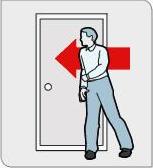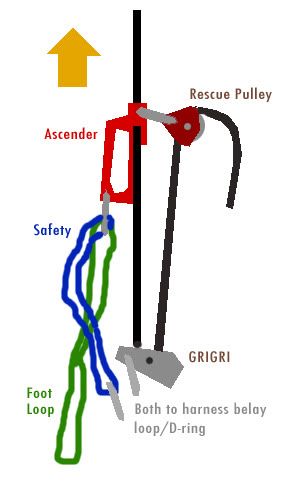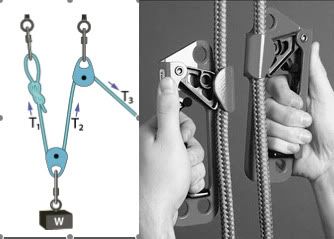 |
 |
|
UER Store
|
|
 order your copy of Access All Areas today!
order your copy of Access All Areas today!
|
|
 |
 MindHacker
   
Location: Suburbs of DC
Gender: Male

If you spot a terrorist arrow, pin it to the wall with your shoulder.
 | |  | Re: a guide to basic rope work
<Reply # 40 on 7/17/2010 3:38 AM >
|  | | | Posted by brokkenladder
Could you use Screw Down Link Rated for 2200LBS instead of a carabiner?
I can get these at the local hardware store for about $2.50 a pop.
|
I use the hardware store carabiners occasionally. They're a pain to use, but for certain links that don't need to be opened much they work.
Posted by vov35
Speaking of which, is climbing gear rated by breaking strength of WLL like most hardware store material? (because dirt cheap 500 pound hardware store carabiners = 9kn breaking strength...)
|
climbing gear is rated by breaking strength. Basically, 2700 lbs or so is enough to break your body, so that's your target. Anything higher than that is overkill. Typically, hardware store hardware is rated by working load, which will be 1/3rd the breaking strength. Thus, a 500lb pulley is good for about 1500 lbs breaking. As long as you aren't lead climbing on it, that's more than enough. Climbing pulleys are much more convenient, but at that time I didn't have the funds for it.
"That's just my opinion. I would, however, advocate for explosive breaching, since speed and looking cool are both concerns in my job."-Wilkinshire |
|
Urban-Explorer
  
Location: Hell's Drain
Gender: Male

 | |  | Re: a guide to basic rope work
<Reply # 41 on 7/27/2010 8:30 PM >
|  | | | very cool thread, I need to expand my knot techniques.
Main Site: urban-explorer.co.cc
Forum Gallery: ue-gallery.co.cc |
|
vov35
 
Location: Maryland
Gender: Male

 | |  | Re: a guide to basic rope work
<Reply # 42 on 8/17/2010 5:12 PM >
|  | | | Posted by MindHacker
I use the hardware store carabiners occasionally. They're a pain to use, but for certain links that don't need to be opened much they work.
climbing gear is rated by breaking strength. Basically, 2700 lbs or so is enough to break your body, so that's your target. Anything higher than that is overkill. Typically, hardware store hardware is rated by working load, which will be 1/3rd the breaking strength. Thus, a 500lb pulley is good for about 1500 lbs breaking. As long as you aren't lead climbing on it, that's more than enough. Climbing pulleys are much more convenient, but at that time I didn't have the funds for it.
|
I did account for that in saying 500lb wll = 9kn breaking...
Why oh why is it impossible to find affordable ascenders?
"Only sheep need a shepherd." -- Voltaire |
|
\/adder
    
Location: DunkarooLand
Gender: Male

I'm the worst of the best but I'm in this race.
 | |  | |  | Re: a guide to basic rope work
<Reply # 43 on 8/17/2010 5:54 PM >
|  | | | Posted by vov35
Why oh why is it impossible to find affordable ascenders?
|
http://www.outdoor...ers_belay_devices/
"No risk, no reward, no fun."
"Go all the way or walk away"
escensi omnis... |
|
vov35
 
Location: Maryland
Gender: Male

 | |  | Re: a guide to basic rope work
<Reply # 44 on 8/17/2010 7:55 PM >
|  | | |
I have a piss poor budget... would a pair of tiblocs be a good idea?
"Only sheep need a shepherd." -- Voltaire |
|
\/adder
    
Location: DunkarooLand
Gender: Male

I'm the worst of the best but I'm in this race.
 | |  | |  | Re: a guide to basic rope work
<Reply # 45 on 8/17/2010 8:20 PM >
|  | | | Posted by vov35
I have a piss poor budget... would a pair of tiblocs be a good idea?
|
No. They can damage the rope and require you to use a specific type/size carabiner.
Either learn to tie prusik knots or save up for better gear.
The rule of tumb with prusik cord is it should be at least 2mm thinner than your main line. You can buy two 10' sections of cord for less than one tibloc and your less likely to screw up.
Also, you could buy one handled ascender and use a prusik for the other, that would be the best way IMO. The handled Petzl Ascension is worth the extra 10 over the handleless Petzl Basic.
[last edit 8/17/2010 8:21 PM by \/adder - edited 1 times]
"No risk, no reward, no fun."
"Go all the way or walk away"
escensi omnis... |
|
bouncewiggle
    
Location: Johnson City, TN
Gender: Female

 | |  | |  | |  | Re: a guide to basic rope work
<Reply # 46 on 8/17/2010 11:18 PM >
|  | | | this place is a great source for cheap climbing gear... at least cheaper than i've seen most places online: http://outdoorgb.com. prusiks work just fine, but they're going to be slow.
"bouncewiggle, now more entertaining than Jell-O" |
|
delusional
   
Location: Hamilton, Ontario
Gender: Male

 | |  | Re: a guide to basic rope work
<Reply # 47 on 8/21/2010 5:44 AM >
|  | | | Posted by bouncewiggle
this place is a great source for cheap climbing gear... at least cheaper than i've seen most places online: http://outdoorgb.com. prusiks work just fine, but they're going to be slow.
|
Any recommendations on something faster? what do you use?
|
|
\/adder
    
Location: DunkarooLand
Gender: Male

I'm the worst of the best but I'm in this race.
 | |  | |  | Re: a guide to basic rope work
<Reply # 48 on 8/21/2010 7:07 AM >
|  | | | Posted by Matt W
Any recommendations on something faster? what do you use?
|
a grigri + ascension is the current setup I'm using. I like it because it's fast and minimal. While not the most efficient it allows for a quick changeover or quick knot bypass.
harness
Petzl Grigri
Petzl Ascension
foot loop
60cm lanyard
2 carabiners
2 mallions / quick links
"No risk, no reward, no fun."
"Go all the way or walk away"
escensi omnis... |
|
bouncewiggle
    
Location: Johnson City, TN
Gender: Female

 | |  | |  | |  | Re: a guide to basic rope work
<Reply # 49 on 8/21/2010 5:20 PM >
|  | | | Posted by Matt W
Any recommendations on something faster? what do you use?
|
Petzl Ascension & Croll for ascending.
I have a figure 8 for rappelling.
I have my stuff setup for frog. It only works well if you have the rope taught at the bottom (like with a heavy bag tied to it that you pull up when you get to the top). Once you get ascenders, you can figure out what setup works best for you. Everyone has a preference and you'll just have to experiment.
Posted by TheVicariousVadder
Petzl Grigri |
You're not *really* supposed to use a grigri for ascending. If it doesn't catch, you'll freefall. The only way an ascender won't catch is if it's locked open.
"bouncewiggle, now more entertaining than Jell-O" |
|
\/adder
    
Location: DunkarooLand
Gender: Male

I'm the worst of the best but I'm in this race.
 | |  | |  | Re: a guide to basic rope work
<Reply # 50 on 8/21/2010 6:25 PM >
|  | | | Posted by bouncewiggle
Petzl Ascension & Croll for ascending.
I have a figure 8 for rappelling.
You're not *really* supposed to use a grigri for ascending. If it doesn't catch, you'll freefall. The only way an ascender won't catch is if it's locked open.
|
Unlikely, seeing as the minute it's weighted it catches and if it doesn't, you lock it down like an atc; plus you still have the handled ascender on the rope unless you were bypassing a knot, and you wouldn't take your ascender off the rope until the grigri was successfully weighted anyways.
The design is rather foolproof without the device physically becoming damaged I can't see it failing, even on 9mm.
Now user error may occur where you panic and grab the release handle and it drops you but that's something a climber would need to be conscious of.
On a straight rope up and down using the grigri/ascender to ascend is simple, it gets a bit more complicated traversing an incline, but that's something that has to be figured out in the field.
"No risk, no reward, no fun."
"Go all the way or walk away"
escensi omnis... |
|
PositivePressure
 
Location: High and low where most don't go
Gender: Male

Set your Tesla coil to broil
 | |  | Re: a guide to basic rope work
<Reply # 51 on 8/21/2010 9:27 PM >
|  | | | I've been using this setup for ascending:

Its extremely efficient thanks to the pulley and the fact that the line beneath doesn't need to be "weighted" to help the rope through like it does with a dual ascender setup, and its very fast and less fatiguing once you configure the foot loop and safety line to the correct lengths. Note that the safety line is only present to provide 2 points of attachment in case of GRIGRI failure. Its important, if you do use the safety backup, to have enough length to allow for full upward extension of your ascender, but not so much that it allows for an extended fall if your GRIGRI were to fail for whatever reason.
|
|
delusional
   
Location: Hamilton, Ontario
Gender: Male

 | |  | Re: a guide to basic rope work
<Reply # 52 on 8/21/2010 11:36 PM >
|  | | | Posted by PositivePressure
I've been using this setup for ascending:
http://i305.photob...ER/Temp/Ascend.jpg
Its extremely efficient thanks to the pulley and the fact that the line beneath doesn't need to be "weighted" to help the rope through like it does with a dual ascender setup, and its very fast and less fatiguing once you configure the foot loop and safety line to the correct lengths. Note that the safety line is only present to provide 2 points of attachment in case of GRIGRI failure. Its important, if you do use the safety backup, to have enough length to allow for full upward extension of your ascender, but not so much that it allows for an extended fall if your GRIGRI were to fail for whatever reason.
|
What is the purpose of the rescue pulley? Is it so you can more easily pull the rope though the grigri? How is the rescue pulley attached the the ascender?
bouncewiggle for descending does the figure 8 put alot of wear on the rope from the friction?
How often does everyone replace their rope?
Sorry for all the questions!
|
|
bouncewiggle
    
Location: Johnson City, TN
Gender: Female

 | |  | |  | |  | Re: a guide to basic rope work
<Reply # 53 on 8/22/2010 12:53 AM >
|  | | | Posted by Matt W
bouncewiggle for descending does the figure 8 put alot of wear on the rope from the friction?
Sorry for all the questions!
|
They twist a lot, so that will contribute to wear on the rope. Aluminum is harder on rope than steel as well.
Don't be sorry for the questions. Better to ask than to end up hurt. =)
"bouncewiggle, now more entertaining than Jell-O" |
|
PositivePressure
 
Location: High and low where most don't go
Gender: Male

Set your Tesla coil to broil
 | |  | Re: a guide to basic rope work
<Reply # 54 on 8/22/2010 4:57 AM >
|  | | | Posted by Matt W
What is the purpose of the rescue pulley? Is it so you can more easily pull the rope though the grigri? How is the rescue pulley attached the the ascender?
bouncewiggle for descending does the figure 8 put alot of wear on the rope from the friction?
How often does everyone replace their rope?
Sorry for all the questions!
|
No worries about the questions! Better to ask and be safe than not ask and risk experiencing the alternative. Still, you should hook up in person with someone who can teach you before you try it yourself.
Disclaimer aside...
The purpose of the rescue pulley is twofold: It redirects the rope downward back toward you so that instead of pulling the rope up through the GRIGRI, you're pulling it downward toward the ground. This is a much more natural, easy motion and makes ascending much easier and less tiring. More importantly though, it creates a 2:1 haul system.

Lets say that, looking at the diagram on the left, you are lifting a 100KG weight. This would mean that T1, T2, and T3 are all the same (50KG), and are equal to one half the weight of the load being lifted (100KG). This is because we distribute the load weight (100KG) evenly between two points by adding our pulley. This is the same principle that cranes use to lift objects. This means that we only have to use half the amount of energy to lift something, as opposed to using a single line NOT redirected through a pulley. In practical terms, if we lifted straight up through the GRIGRI, we would have to apply an amount of force equal to the weight being moved (actually it'd be your body weight PLUS whatever friction resistance is applied as the rope passes through your GRIGRI). With the pulley, the force needed to move your body weight is cut in half. The downside to this is that for every length of rope we pull through, our load only lifts half that distance (If you pull 3 feet of rope through the system, you only ascend 1.5 feet). Ideally, you're using the muscles in your leg (the one in your foot loop) to lift your body weight, but adding the pulley and that mechanical advantage sure does help. Using this setup I can easily and very quickly ascend 150ft in increments of 3 feet or so per stroke without getting too tired at all. Hope that makes a bit of sense!
The pulley is attached to the ascender via the hole in the top of the ascender itself. The photo to the right of the diagram shows two CMI ultrascenders. Pretty much all ascenders are relatively similar. If we wanted to attach our pulley to the left ascender, we would put a carabiner through the top-most hole and extend it out to the right, so it would pass around and encircle the rope. Then our pulley would attach to that carabiner. Our leg loop would attach to one of the two lower holes. I couldn't find a decent photo of this, and all my gear is in a jumble out in my vehicle so no pics! Sorry. Its pretty simple, though 
I don't replace my rope in accordance with any set schedule or anything. Just when it gets worn or if there is damage that would warrant replacement. I generally check it before each use and do another quick check afterward as I'm stowing it.
I'd say if you're just starting out, it might be a good idea to begin by using an ATC style descender vs. a figure 8. Most offer varying amounts of friction (more than an 8) by using opposite sides of the device, and do not twist the rope (or induce spinning while in free-hang) like the 8 will. They're also more difficult to rig incorrectly. That being said, I prefer using an 8 myself for a lot of varying reasons, but a lot of it is task dependent. In the end, you use what you're comfortable with.
|
|
vov35
 
Location: Maryland
Gender: Male

 | |  | Re: a guide to basic rope work
<Reply # 55 on 8/25/2010 1:10 AM >
|  | | | Posted by PositivePressure
you are lifting a 100KG weight
|
with ascenders? **mutters something about chubbies**
anyway: given that I have a very very limited budget, how much of a difference does a cheap harness make as compared to a swiss seat from 1" wide webbing?
"Only sheep need a shepherd." -- Voltaire |
|
\/adder
    
Location: DunkarooLand
Gender: Male

I'm the worst of the best but I'm in this race.
 | |  | |  | Re: a guide to basic rope work
<Reply # 56 on 8/25/2010 1:14 AM >
|  | | | Posted by vov35
with ascenders? **mutters something about chubbies**
anyway: given that I have a very very limited budget, how much of a difference does a cheap harness make as compared to a swiss seat from 1" wide webbing?
|
http://www.uer.ca/...rrpage=2&pp#post21
"No risk, no reward, no fun."
"Go all the way or walk away"
escensi omnis... |
|
MindHacker
   
Location: Suburbs of DC
Gender: Male

If you spot a terrorist arrow, pin it to the wall with your shoulder.
 | |  | Re: a guide to basic rope work
<Reply # 57 on 8/25/2010 4:26 AM >
|  | | | re: 9kn breaking strength: Yeah, I was agreeing with you.
Descenders:
Figure 8's twist the line, which makes you spin in circles on a free rappel, but they won't hurt the rope any more than carrying it around and tying knots in it does. You can get an ATC for about the same price though, so if you haven't bought anything yet, get that instead. Bonus points: it can't flip into a girth hitch on you.
Ascenders:
Tiblocs will hurt the rope though. I used (5mm) prussics for years before DjCraig let my try out his ascenders and they are sooo much faster. Keep stalking ebay - for $40 I found a pair of cmi ultrascenders, a pulley, and a few other bits of climbing gear. There was some rust on them that came from other gear left in the box but after I cleaned / inspected them they work good as new.
Harness:
For a security harness or for short rappels (50 feet) it doesn't really matter. If you expect to take a fall (not might take a fall), get something better than just webbing. If you plan to do long rappels, get a nice, brand name harness. If you want to do tower work and not rappel, get a OSHA full body harness. Honestly, a harness is one of the few places you can skimp, because as long as it's not falling apart a cheap harness will save you just as well as an expensive harness, only it might hurt more. And you can get a good 2 or 3 inch wwebbing harness for pretty cheap that will be more convenient and significantly less painful than a 1" swiss seat.
Shoes:
I just learned that you should wear looser (but not loose) shoes for crack climbing (since it helps foot jams), and tighter shoes for face climbing. But tbh, for urbexing a pair of approach shoes will work better. A bit more sturdy, but the rubber is still sticky and you can still feel the rocks (or what have you) under you.
Rope:
As long as the core isn't poking out of the sides (well, more than a little) and it feels strong internally, I won't get a new rope. You can check by making a sharp bend in the rope and rolling the loop down the rope. It should roll smoothly and make the same diameter bend everywhere on the rope.
[last edit 8/25/2010 4:29 AM by MindHacker - edited 1 times]
"That's just my opinion. I would, however, advocate for explosive breaching, since speed and looking cool are both concerns in my job."-Wilkinshire |
|
bouncewiggle
    
Location: Johnson City, TN
Gender: Female

 | |  | |  | |  | Re: a guide to basic rope work
<Reply # 58 on 8/25/2010 10:48 PM >
|  | | | Posted by vov35
anyway: given that I have a very very limited budget, how much of a difference does a cheap harness make as compared to a swiss seat from 1" wide webbing?
|
Look for sales or harnesses on eBay. They're well worth it. You can find many of them for under $50 on gear websites (try Backcountry and REI's outlet pages), and even cheaper on eBay (my exact harness, minus the color, for $7 http://cgi.ebay.co...ain_0#ht_500wt_934).
"bouncewiggle, now more entertaining than Jell-O" |
|
vov35
 
Location: Maryland
Gender: Male

 | |  | Re: a guide to basic rope work
<Reply # 59 on 9/19/2010 7:45 PM >
|  | | |
So, I've worked some more on SRT and such, but I'm still having difficulties with finding anchors on some buildings. Obviously cams + crumbly concrete aren't a wise combination, and in many cases it's possible to get a rope up beforehand.
The question is, what do you guys anchor to generally?
For example, I wanted to practice SRT at Henryton, but I honestly can't find any convenient anchors:
Are AC units like these safe for tying to? (particularly the I-beams)
"Only sheep need a shepherd." -- Voltaire |
|
|
|
All content and images copyright © 2002-2024 UER.CA and respective creators. Graphical Design by Crossfire.
To contact webmaster, or click to email with problems or other questions about this site:
UER CONTACT
View Terms of Service |
View Privacy Policy |
Server colocation provided by Beanfield
This page was generated for you in 171 milliseconds. Since June 23, 2002, a total of 739422714 pages have been generated.
|
|

 order your copy of Access All Areas today!
order your copy of Access All Areas today!















